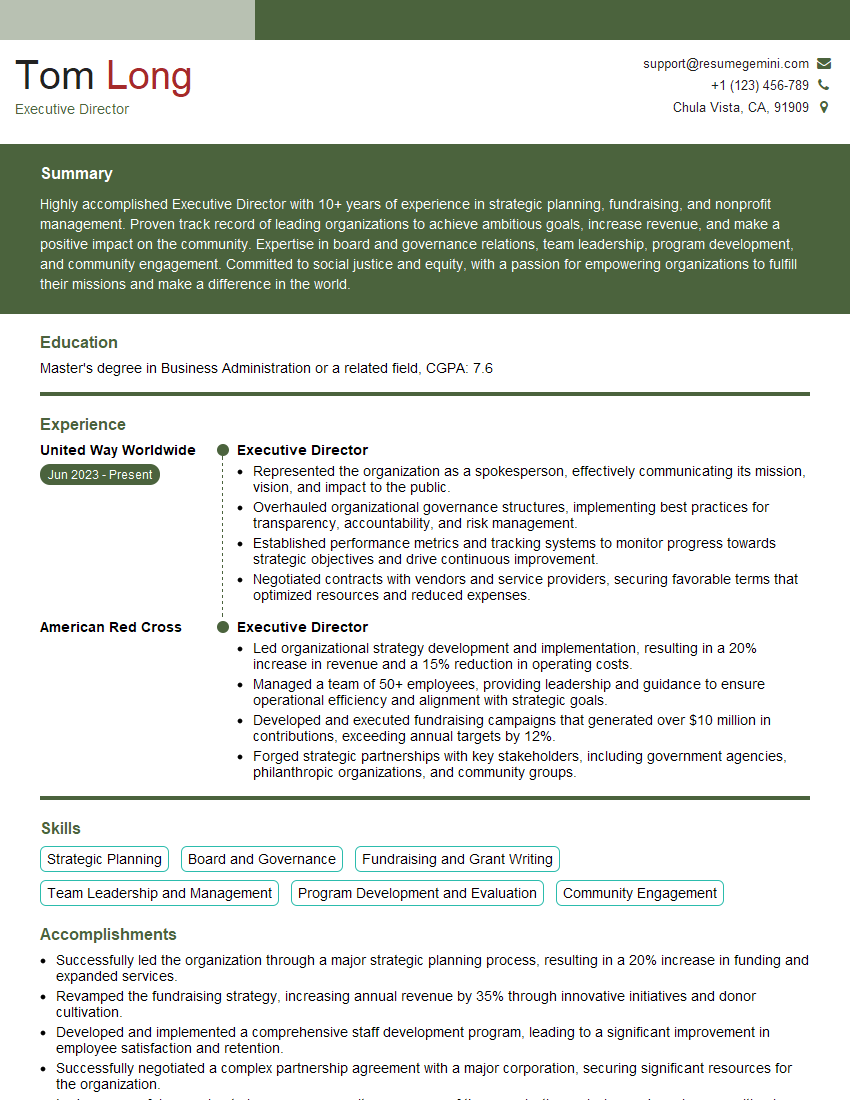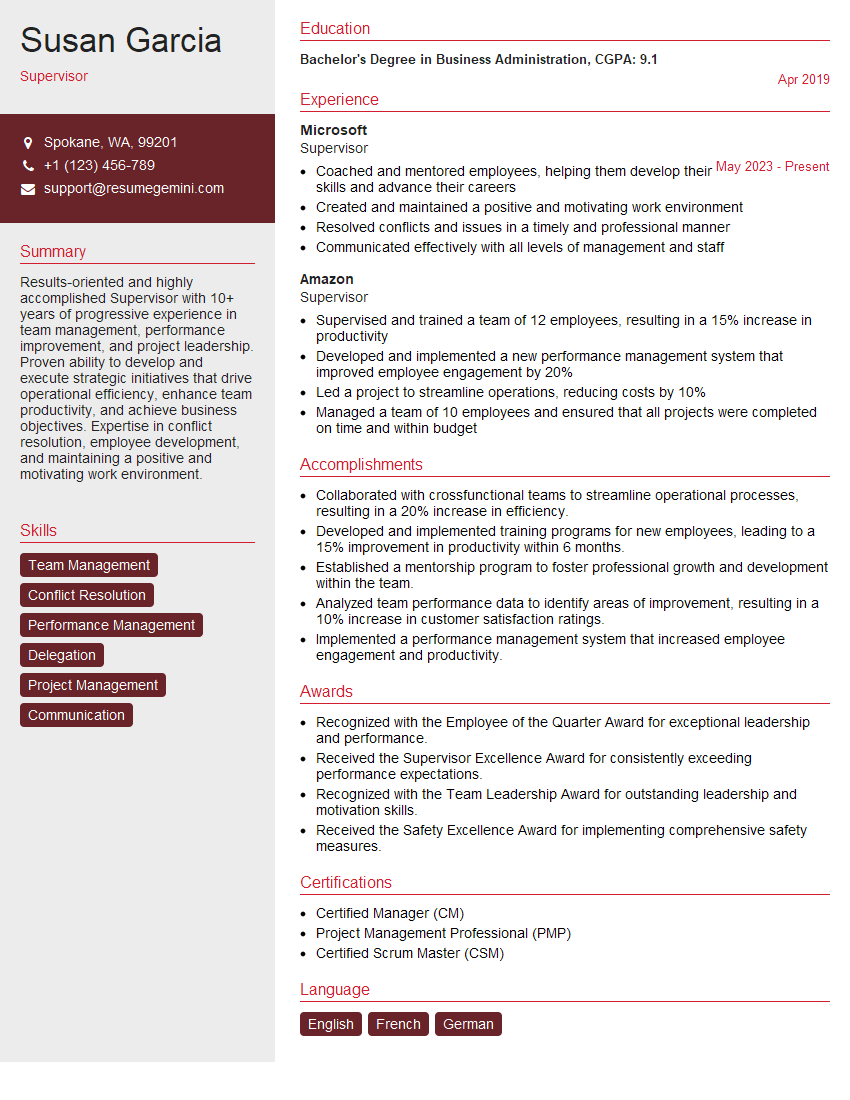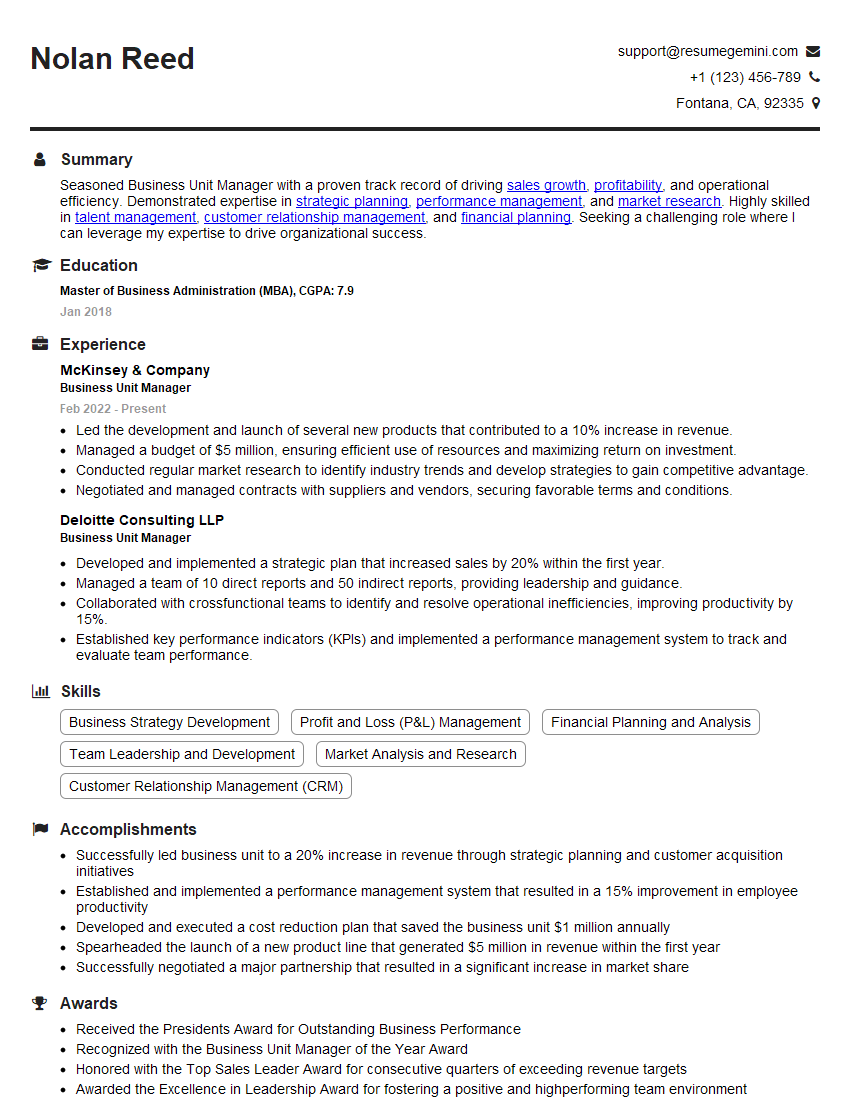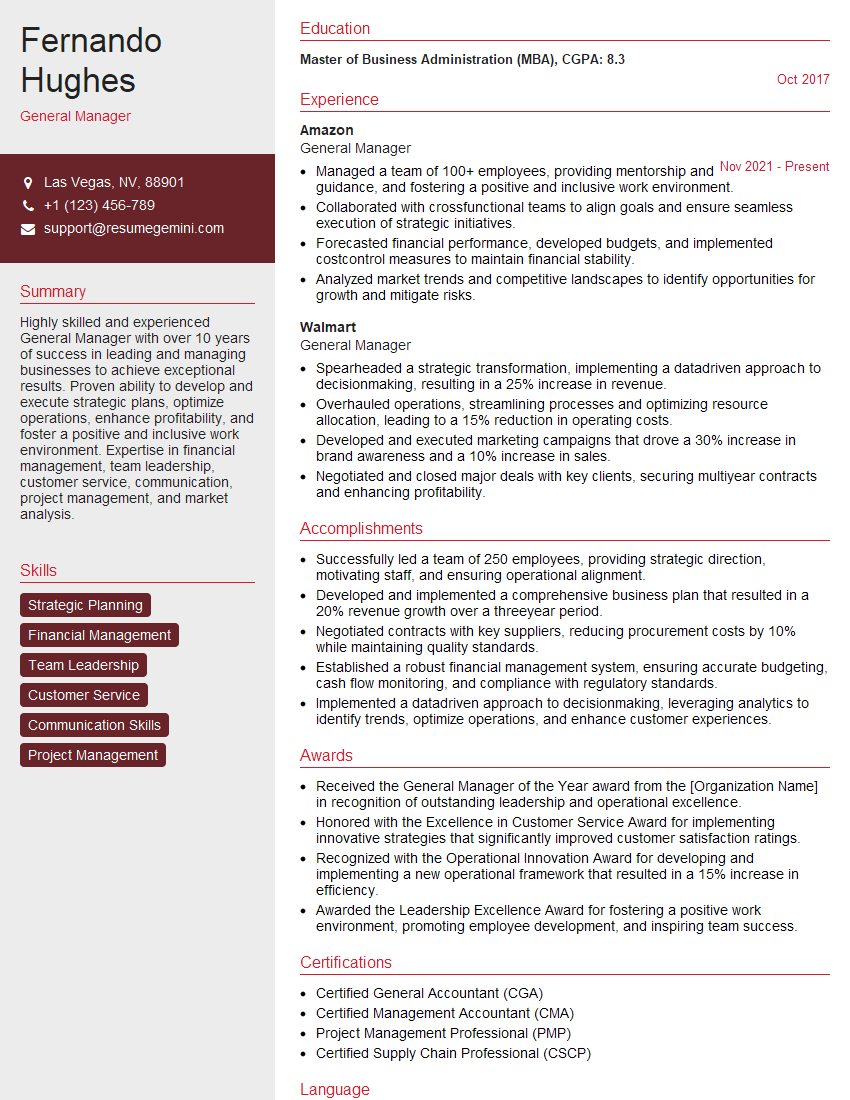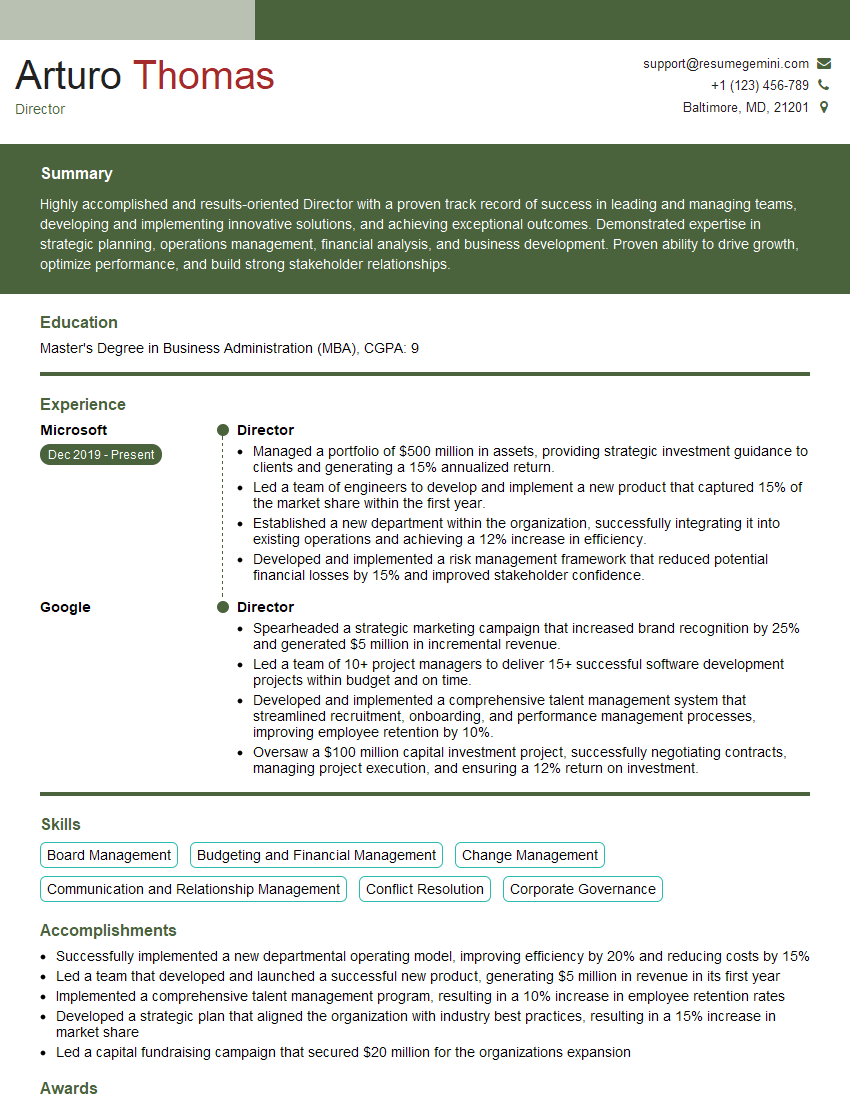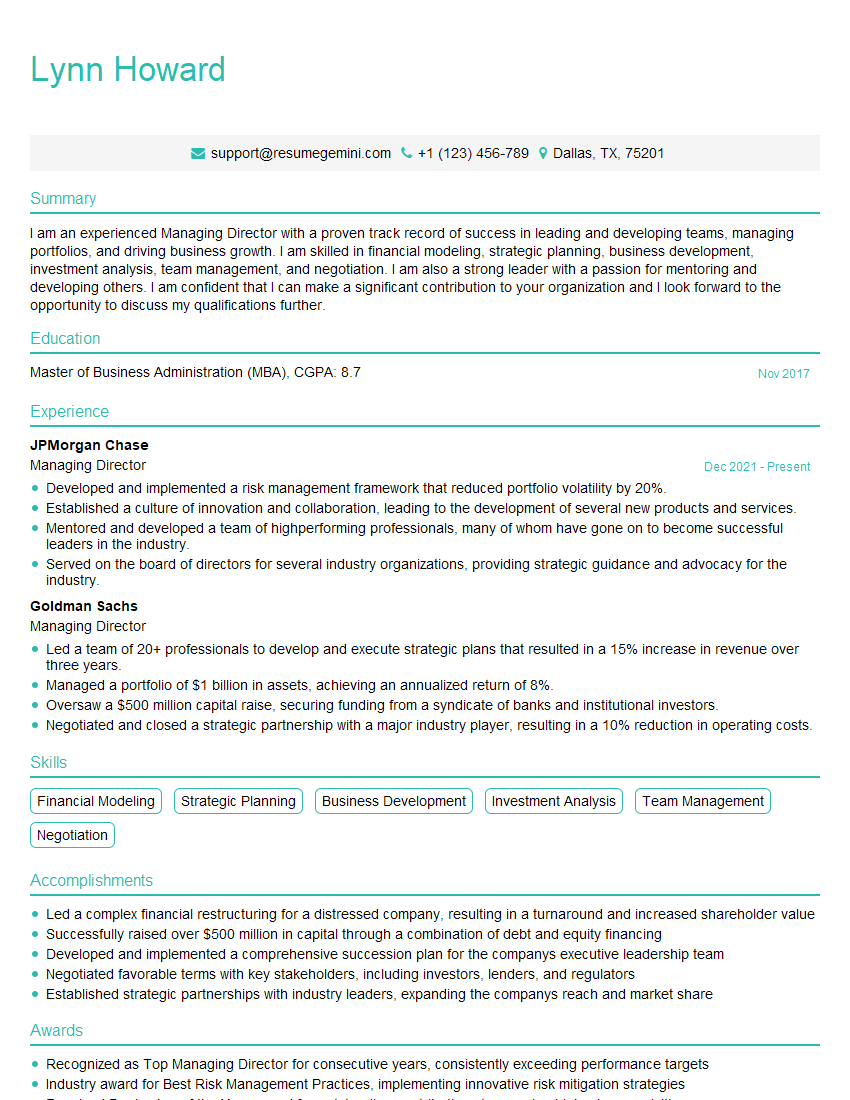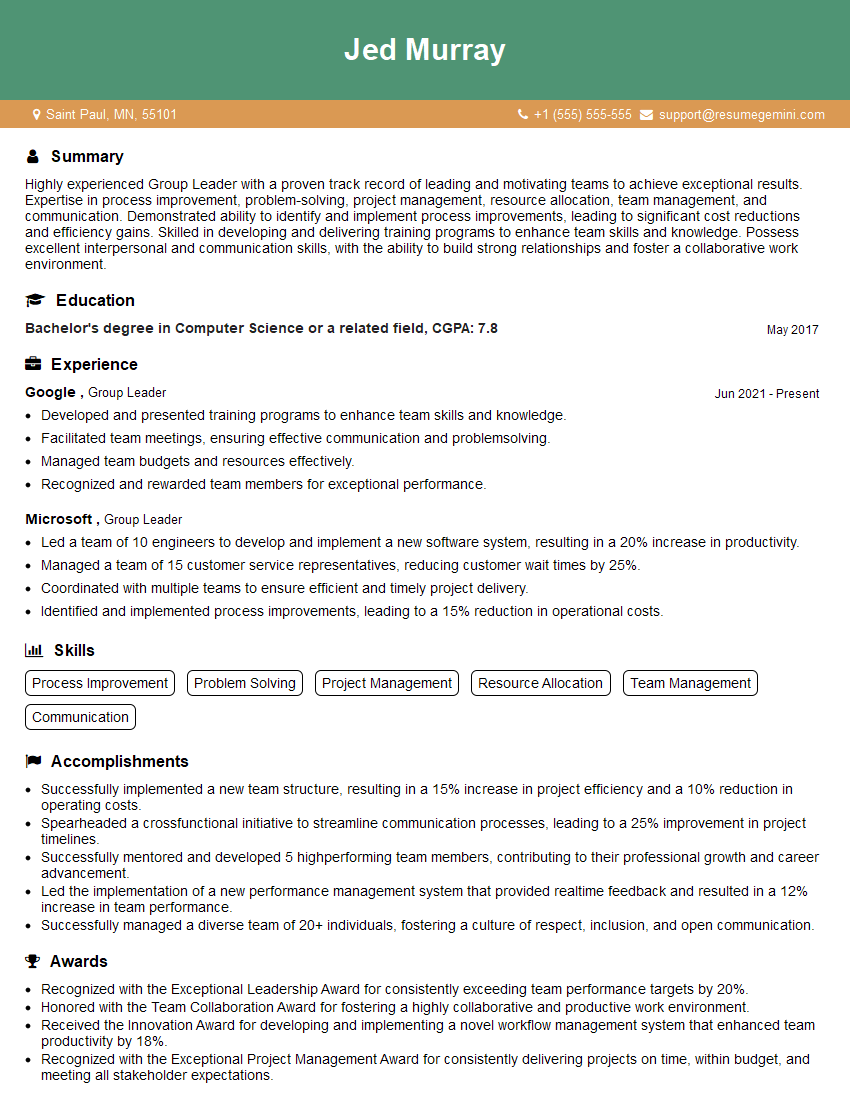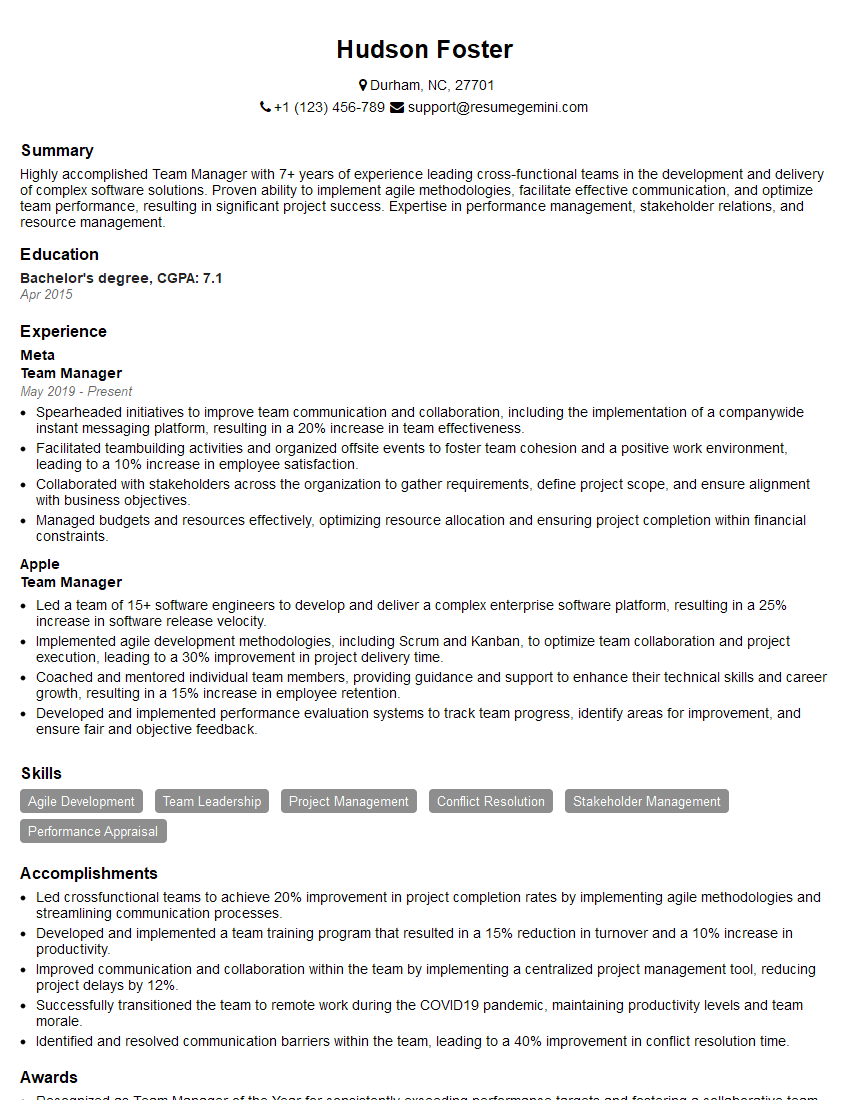Unlock your full potential by mastering the most common Team Motivation and Leadership interview questions. This blog offers a deep dive into the critical topics, ensuring you’re not only prepared to answer but to excel. With these insights, you’ll approach your interview with clarity and confidence.
Questions Asked in Team Motivation and Leadership Interview
Q 1. Describe your experience in fostering a positive team environment.
Fostering a positive team environment is crucial for productivity and morale. It’s about creating a space where everyone feels valued, respected, and empowered to contribute their best work. My approach is multifaceted and focuses on building trust, open communication, and mutual respect.
- Building Trust: I prioritize transparency in communication, sharing information openly and honestly, and being accountable for my actions. I actively listen to team members’ concerns and perspectives, showing genuine interest in their well-being.
- Open Communication: I encourage regular team meetings, both formal and informal, to facilitate open dialogue. This includes one-on-one check-ins to understand individual challenges and progress. I also use various communication tools to ensure efficient information sharing.
- Mutual Respect: I foster a culture of appreciation by acknowledging individual and team accomplishments. I actively promote collaboration and celebrate successes together. I also actively address any instances of disrespect or negativity.
- Team Building Activities: I incorporate team-building activities, both work-related and social, to strengthen relationships and promote camaraderie. These can range from collaborative problem-solving exercises to casual team lunches.
For example, in a previous role, I initiated a weekly ‘Kudos’ session where team members could publicly acknowledge each other’s contributions. This simple act significantly boosted morale and fostered a more collaborative atmosphere.
Q 2. How do you motivate team members facing challenging projects?
Motivating team members during challenging projects requires a combination of understanding, support, and strategic goal setting. It’s about empowering them to overcome obstacles and feel a sense of accomplishment.
- Clear Goals and Expectations: I ensure that project goals are clearly defined, measurable, achievable, relevant, and time-bound (SMART). This gives team members a clear understanding of what they need to achieve.
- Breaking Down Tasks: I break down large, complex projects into smaller, more manageable tasks. This makes the project less daunting and allows for more frequent positive reinforcement.
- Providing Support and Resources: I provide team members with the necessary resources, training, and support to succeed. This might include access to relevant tools, mentorship opportunities, or additional training.
- Recognition and Appreciation: I regularly recognize and appreciate team members’ efforts and achievements, both big and small. This reinforces positive behavior and boosts morale.
- Addressing Challenges Proactively: I address challenges and roadblocks proactively, working with the team to find solutions. This demonstrates leadership and commitment to the team’s success.
For instance, when facing a tight deadline on a particularly complex project, I organized daily stand-up meetings to track progress, identify roadblocks, and ensure everyone felt supported and informed. We celebrated milestones along the way, keeping the team energized and focused.
Q 3. Explain your approach to conflict resolution within a team.
My approach to conflict resolution prioritizes open communication, empathy, and finding mutually acceptable solutions. I aim to transform conflict into an opportunity for growth and improved team dynamics.
- Active Listening: I encourage all parties involved to fully express their perspectives without interruption. I focus on understanding the root cause of the conflict, rather than simply addressing surface-level issues.
- Neutral Facilitation: I act as a neutral facilitator, guiding the conversation and ensuring everyone feels heard and respected. I avoid taking sides and focus on helping the team reach a resolution.
- Collaborative Problem-Solving: I guide the team towards collaborative problem-solving, brainstorming potential solutions together. This empowers the team to take ownership of the resolution process.
- Mediation, if Necessary: If the conflict remains unresolved, I may involve a neutral third party mediator to facilitate a more objective resolution.
- Follow-up: After the conflict is resolved, I follow up with the involved parties to ensure the solution is working and to address any lingering concerns.
In a past situation, two team members had a disagreement about project strategy. I facilitated a meeting where both could express their viewpoints. Through guided discussion, we identified a compromise that incorporated elements of both their proposals. This not only solved the immediate conflict but also strengthened their working relationship.
Q 4. How do you delegate tasks effectively to maximize team productivity?
Effective delegation is about matching tasks to individual strengths and skillsets, empowering team members, and fostering ownership. It’s not just about assigning tasks; it’s about building capacity and trust within the team.
- Understanding Team Member Strengths: I carefully assess each team member’s skills, experience, and interests to assign tasks that align with their capabilities. This maximizes individual contribution and job satisfaction.
- Clear Instructions and Expectations: I provide clear instructions, deadlines, and expected outcomes for each delegated task. This removes ambiguity and ensures everyone is on the same page.
- Providing Necessary Resources: I ensure team members have the necessary resources, tools, and support to complete their tasks successfully. This might include access to information, training, or mentorship.
- Empowering and Trusting Team Members: I delegate with trust, allowing team members the autonomy to manage their tasks and make decisions within defined parameters. This fosters ownership and responsibility.
- Regular Check-ins and Feedback: I provide regular check-ins and feedback to monitor progress, address challenges, and offer support. This ensures tasks are completed efficiently and effectively.
For example, when managing a large software development project, I delegated specific modules to different developers based on their expertise. This approach ensured efficient completion while also offering them opportunities for growth and development.
Q 5. How do you measure team performance and identify areas for improvement?
Measuring team performance requires a balanced approach that considers both quantitative and qualitative factors. It’s about identifying areas of strength and areas needing improvement.
- Quantitative Metrics: I use metrics like project completion rates, budget adherence, and on-time delivery to assess overall team productivity. These provide concrete data to track progress.
- Qualitative Metrics: I gather qualitative data through regular feedback sessions, 360-degree reviews, and informal observations. This assesses team collaboration, communication effectiveness, and overall morale.
- Key Performance Indicators (KPIs): I establish clear KPIs aligned with team goals and regularly monitor progress towards these goals. This ensures the team remains focused and allows for timely adjustments.
- Regular Performance Reviews: I conduct regular performance reviews with individual team members and the team as a whole to discuss progress, identify challenges, and create improvement plans.
- Process Improvement Initiatives: Based on the data collected, I identify areas for improvement and implement process improvements to enhance team efficiency and effectiveness.
For instance, I might track the number of bugs found in software releases (quantitative) and team members’ satisfaction with the development process (qualitative) to assess performance and pinpoint areas for improvement in both coding practices and team communication.
Q 6. Share an example of a time you successfully motivated a low-performing team member.
In a previous role, a team member consistently underperformed, missing deadlines and producing subpar work. Instead of direct criticism, I took a different approach.
- Understanding the Root Cause: I scheduled a one-on-one meeting to understand the underlying reasons for their underperformance. It turned out they were struggling with a new technology and felt overwhelmed.
- Providing Support and Training: I provided them with additional training and mentorship on the new technology. I paired them with a more experienced team member to provide guidance and support.
- Setting Realistic Goals: I worked with them to set realistic, achievable goals that gradually increased in complexity. This built their confidence and allowed for consistent progress.
- Positive Reinforcement: I focused on recognizing and rewarding their small successes. This positive reinforcement motivated them to continue improving.
Through this supportive approach, the team member not only improved their performance but also developed greater confidence and a stronger sense of belonging within the team.
Q 7. How do you handle disagreements amongst team members?
Handling disagreements effectively requires a structured approach that focuses on respectful communication, problem-solving, and maintaining team unity. The key is to manage the conflict constructively rather than suppressing it.
- Create a Safe Space: I encourage a culture where team members feel safe to express their opinions and disagreements without fear of retribution. This is essential for open and honest communication.
- Facilitate Open Dialogue: I facilitate open and respectful dialogue among the disagreeing parties, ensuring everyone has an opportunity to express their perspective clearly and without interruption.
- Identify Common Ground: I help the team identify common ground and shared goals. This can assist in bridging the gap between differing viewpoints.
- Focus on Solutions: I encourage the team to focus on finding solutions, rather than dwelling on the disagreement itself. This shifts the focus from blame to problem-solving.
- Document the Agreement: Once a resolution is reached, I ensure it’s documented and communicated to all relevant parties to prevent future misunderstandings.
For instance, if two team members have a disagreement about a design decision, I’d guide them to present their rationales, listen attentively to each other’s points, and explore alternative designs that address both concerns. This promotes a collaborative solution and prevents future conflicts stemming from the same issue.
Q 8. What strategies do you use to build trust and rapport within a team?
Building trust and rapport is the cornerstone of effective teamwork. It’s not a one-time event, but a continuous process requiring consistent effort and genuine interaction. My strategy involves a multi-pronged approach focusing on transparency, empathy, and proactive communication.
- Open Communication: I encourage open and honest dialogue, fostering an environment where team members feel comfortable sharing their ideas, concerns, and even failures without fear of judgment. Regular team meetings, both formal and informal, are crucial for this. I also make a point of actively listening to each team member’s perspective.
- Transparency and Accountability: I ensure transparency in decision-making processes, explaining the rationale behind choices and involving the team where appropriate. This builds trust by showing that I value their input and consider their perspectives. Likewise, I hold myself accountable for my actions and decisions, modeling the behavior I expect from the team.
- Empathy and Understanding: I strive to understand each team member’s individual strengths, weaknesses, and working styles. This allows me to tailor my communication and support to their specific needs. Showing genuine interest in their well-being, both professionally and personally (within appropriate professional boundaries), strengthens the team bond.
- Shared Goals and Values: Clearly defining shared goals and values ensures everyone is working towards a common purpose, fostering a sense of unity and shared purpose. This helps individuals feel connected and invested in the team’s success.
For example, in a previous project, a team member was hesitant to share an idea due to past negative experiences. By actively listening to their concerns and assuring them that their input was valued and that a supportive environment was in place for experimentation, I was able to build their confidence and foster trust. Their subsequent contributions were invaluable to the project’s success.
Q 9. Describe your leadership style and how it impacts team dynamics.
My leadership style is best described as transformational, blending elements of servant leadership. I believe in empowering my team members to take ownership and initiative, while simultaneously providing guidance and support. This approach aims to inspire and motivate the team to achieve shared goals, exceeding expectations.
- Empowerment: I delegate tasks based on individual strengths and provide the necessary resources and autonomy for team members to excel. I trust my team to make decisions and solve problems independently, fostering a sense of responsibility and ownership.
- Mentorship and Coaching: I act as a mentor and coach, providing guidance, feedback, and support to help team members develop their skills and reach their full potential. This involves identifying their strengths and growth areas and tailoring development plans accordingly.
- Collaboration and Communication: I prioritize open communication and collaboration, encouraging feedback and active listening to foster a positive team dynamic. Regular check-ins and team meetings ensure that everyone feels heard and valued.
- Vision and Inspiration: I set a clear vision for the team, articulating the goals and inspiring them to work towards a common purpose. This helps align everyone’s efforts and motivates them to strive for excellence.
This leadership style fosters a collaborative and innovative environment. Team members feel empowered to contribute their ideas, leading to increased engagement, creativity, and ultimately, improved productivity and higher-quality results. For instance, by empowering my team to take the lead on a specific project, they delivered innovative solutions and exceeded expectations.
Q 10. How do you provide constructive feedback to team members?
Constructive feedback is crucial for growth and improvement. My approach prioritizes a positive and supportive environment, focusing on specific behaviors rather than personal attacks. I use the SBI (Situation, Behavior, Impact) model.
- Situation: I clearly describe the specific situation where the behavior occurred.
- Behavior: I objectively describe the behavior that needs improvement, avoiding subjective judgments.
- Impact: I explain the impact of the behavior on the team, project, or individuals involved.
For instance, instead of saying “You’re disorganized,” I would say, “During the last project meeting, the presentation was delayed because the necessary materials weren’t ready. This impacted the overall schedule and limited our Q&A time. Let’s discuss how we can improve organization and preparation for future meetings.”
I also ensure the feedback is delivered privately and respectfully, allowing for open discussion and collaboration on solutions. I encourage the team member to share their perspective, facilitating a two-way conversation aimed at growth, not criticism. Follow-up is crucial to ensure that the feedback is understood and acted upon.
Q 11. How do you recognize and reward team achievements?
Recognizing and rewarding team achievements is vital for boosting morale and reinforcing positive behaviors. My approach is multifaceted and tailored to individual preferences.
- Public Acknowledgement: I publicly acknowledge and celebrate team successes during meetings, emails, or company-wide communications. This shows appreciation and reinforces positive behavior.
- Individualized Rewards: I also provide individualized rewards, such as opportunities for professional development, increased responsibilities, or small tokens of appreciation, recognizing specific contributions. These could include extra vacation time, a gift card, or a letter of commendation.
- Team Celebrations: I organize team celebrations, such as team lunches or outings, to foster camaraderie and reinforce the sense of shared accomplishment. This could include an informal celebration or a formal event.
- Feedback and Recognition Platforms: I encourage using feedback and recognition platforms so that team members can appreciate and praise each other’s work regularly. This encourages a culture of mutual support and appreciation.
The key is to make the rewards meaningful and aligned with individual team member values and preferences. For example, a team member who values professional growth might appreciate a training course, while another might value extra time off.
Q 12. How do you adapt your leadership style to different team members and situations?
Adaptability is key to effective leadership. I tailor my approach to the unique needs of individual team members and the context of each situation. Understanding individual personalities and communication styles is crucial.
- Individualized Approaches: I recognize that different individuals respond to different leadership styles. Some thrive with detailed instructions, others with broad outlines and autonomy. I adapt my communication and guidance accordingly. For example, a detail-oriented team member will benefit from a more structured approach, while a creative one might benefit from a more open-ended, exploratory approach.
- Situational Awareness: I assess the circumstances and adjust my leadership style accordingly. A crisis situation might call for more directive leadership, while a routine task might benefit from a more collaborative approach.
- Feedback and Adjustment: I actively solicit feedback from team members on my leadership style and make adjustments based on their input. This ensures that my approach remains relevant and effective.
For example, in a fast-paced project, I might adopt a more directive leadership style to ensure efficient task completion. Conversely, in a project requiring innovative solutions, I would foster a more collaborative environment to encourage creative thinking and brainstorming.
Q 13. How do you handle pressure and stress within a demanding team environment?
Handling pressure and stress in a demanding environment requires a proactive and multi-faceted strategy. It’s crucial to maintain a calm demeanor, even under pressure, and model healthy coping mechanisms for the team.
- Proactive Planning and Organization: Effective planning, clear communication, and proactive risk management minimize unforeseen challenges and reduce stress levels. This includes setting realistic deadlines, allocating resources efficiently, and having contingency plans in place.
- Stress Management Techniques: I encourage the team to use stress management techniques, such as mindfulness exercises, breaks, or physical activity, and I model these techniques myself. This could involve promoting regular breaks, offering access to mindfulness resources, or creating a positive team culture where open communication and support are encouraged.
- Open Communication and Support: Creating a supportive environment where team members can openly discuss their concerns and seek help reduces feelings of isolation and overwhelm. This might include regular check-ins with team members to discuss individual challenges and offer assistance.
- Delegation and Prioritization: Effectively delegating tasks and prioritizing responsibilities ensures workloads are manageable and prevents burnout. This involves understanding each team member’s strengths and limitations and assigning tasks accordingly.
In a past demanding project, I implemented a daily stand-up meeting to track progress, address challenges promptly, and ensure everyone felt heard. This streamlined communication, minimized misunderstandings, and reduced overall stress levels for the entire team.
Q 14. Describe your experience with setting and communicating team goals.
Setting and communicating team goals is fundamental to achieving success. My approach ensures clarity, collaboration, and accountability.
- SMART Goals: I use the SMART framework (Specific, Measurable, Achievable, Relevant, Time-bound) to ensure that goals are clear, measurable, and realistic. For example, instead of saying “improve customer satisfaction,” a SMART goal might be “increase customer satisfaction scores by 15% by the end of the quarter, as measured by our customer feedback survey.”
- Collaborative Goal Setting: I involve the team in the goal-setting process to ensure buy-in and ownership. This increases commitment and motivation.
- Clear Communication: I clearly communicate goals and expectations to the team, using various methods to ensure that everyone understands their roles and responsibilities. This might include written documents, presentations, and regular discussions.
- Regular Monitoring and Feedback: I regularly monitor progress towards goals and provide feedback to the team. This ensures that any necessary adjustments are made promptly. This might involve the use of project management tools, regular progress reports, and ongoing feedback sessions.
In one project, the team collectively defined SMART goals, outlining individual contributions and deadlines. This transparent process fostered a sense of shared ownership, leading to enhanced motivation and exceptional results.
Q 15. How do you facilitate effective communication within a team?
Effective communication is the lifeblood of any successful team. It’s not just about talking; it’s about ensuring everyone understands, feels heard, and can contribute meaningfully. My approach focuses on several key strategies:
Open and Transparent Communication Channels: I establish multiple avenues for communication – regular team meetings, instant messaging platforms (like Slack or Microsoft Teams), email for formal updates, and even informal coffee chats. This caters to different communication styles and ensures information isn’t siloed.
Active Listening and Feedback: I prioritize active listening, ensuring I understand team members’ perspectives before responding. I also encourage open and constructive feedback, both upwards and downwards, creating a safe space for honest dialogue. This might involve using techniques like the ‘Start, Stop, Continue’ feedback model.
Clear and Concise Communication: I emphasize clear and concise communication, avoiding jargon and ambiguity. I use visual aids like charts and graphs when appropriate to make information easier to digest. For instance, when explaining a complex project, I might use a Gantt chart to illustrate timelines and dependencies.
Regular Check-ins: I conduct regular one-on-one check-ins with each team member to address individual concerns, provide support, and track progress. These meetings are not just about performance; they’re about fostering a strong working relationship.
For example, in a previous project, we used a daily stand-up meeting to ensure everyone was aligned on priorities and to identify any roadblocks early. This prevented small issues from escalating into larger problems.
Career Expert Tips:
- Ace those interviews! Prepare effectively by reviewing the Top 50 Most Common Interview Questions on ResumeGemini.
- Navigate your job search with confidence! Explore a wide range of Career Tips on ResumeGemini. Learn about common challenges and recommendations to overcome them.
- Craft the perfect resume! Master the Art of Resume Writing with ResumeGemini’s guide. Showcase your unique qualifications and achievements effectively.
- Don’t miss out on holiday savings! Build your dream resume with ResumeGemini’s ATS optimized templates.
Q 16. How do you ensure team members feel valued and respected?
Making team members feel valued and respected is crucial for fostering a positive and productive work environment. It’s about recognizing their individual contributions and creating a culture of appreciation. Here’s how I approach it:
Recognition and Appreciation: I regularly acknowledge and appreciate both individual and team accomplishments, both publicly and privately. This might include verbal praise, written thank-you notes, or highlighting achievements in team meetings. I believe in celebrating both big and small wins.
Empowerment and Autonomy: I empower team members by giving them ownership of their work and trusting them to make decisions within their scope of responsibility. This demonstrates confidence in their abilities and fosters a sense of ownership.
Inclusive and Respectful Environment: I actively foster an inclusive and respectful environment where everyone feels comfortable sharing their ideas and opinions, regardless of their background or seniority. I actively address any instances of disrespect or discrimination.
Personalized Development Opportunities: I invest in the professional development of each team member by identifying their strengths and weaknesses and providing opportunities for growth, such as mentorship, training programs, or challenging assignments.
For instance, in my previous role, I implemented a peer-recognition program where team members could nominate each other for exceptional work. This created a positive and collaborative atmosphere where everyone felt appreciated.
Q 17. How do you onboard new team members and integrate them into the team culture?
Onboarding new team members effectively is critical for their success and integration into the team. It’s more than just paperwork; it’s about building relationships and setting them up for success. My strategy involves:
Structured Onboarding Program: I develop a structured onboarding program that includes a clear plan for the first week, month, and three months, outlining tasks, expectations, and training opportunities.
Buddy System: I assign a ‘buddy’ to each new team member—a more experienced team member who can provide guidance, answer questions, and help them navigate the company culture.
Team Introductions and Social Events: I facilitate introductions to the team and arrange informal social events to help build relationships and integrate the new member into the team culture. This helps them build rapport outside of the formal work setting.
Regular Check-ins and Feedback: I schedule regular check-ins with the new team member to address any questions or concerns, provide feedback, and track their progress. I make sure they feel comfortable asking questions, no matter how trivial they may seem.
Clear Role Expectations and Goals: From the start, I ensure that the new team member has a clear understanding of their role, responsibilities, and performance goals. This avoids confusion and helps them focus on their priorities.
For example, in a past project, we created a welcome packet for new hires containing important information, company policies, and a list of key contacts. This streamlined the onboarding process and made the transition smoother for new team members.
Q 18. What are your strategies for promoting teamwork and collaboration?
Promoting teamwork and collaboration requires a conscious effort to foster a supportive and collaborative environment. My strategies include:
Team-Building Activities: I incorporate team-building activities, both formal and informal, to help team members get to know each other better and build rapport. This could range from problem-solving exercises to casual social events.
Collaborative Tools and Technologies: I leverage collaborative tools like project management software (e.g., Jira, Asana) and shared document platforms (e.g., Google Docs, SharePoint) to facilitate seamless information sharing and teamwork.
Cross-Functional Collaboration: I encourage cross-functional collaboration by involving team members from different departments in projects and initiatives. This promotes a broader understanding of the business and improves communication across departments.
Shared Goals and Objectives: I clearly define shared goals and objectives, ensuring that everyone understands how their individual contributions contribute to the overall success of the team. A shared vision unifies the team and motivates collective effort.
Conflict Resolution Strategies: I actively address conflicts and disagreements, using conflict resolution strategies to encourage constructive dialogue and find solutions that work for everyone. I don’t shy away from difficult conversations but approach them with empathy and a focus on finding common ground.
For example, in one project, we used a Kanban board to visually track progress and ensure everyone was aware of dependencies and deadlines. This fostered transparency and enhanced collaboration.
Q 19. How do you handle a situation where a team member consistently underperforms?
Addressing underperformance requires a sensitive yet firm approach. It’s crucial to understand the root cause before taking action. My process typically involves:
One-on-One Meeting: I begin with a private one-on-one meeting to discuss the performance issues with the team member. This meeting is not about blame; it’s about understanding the reasons behind the underperformance. Is there a lack of skills, training, support, or motivation?
Performance Improvement Plan (PIP): If the underperformance continues, I develop a Performance Improvement Plan (PIP) outlining specific goals, expectations, and timelines for improvement. This plan includes regular check-ins and support to help the employee improve their performance.
Provide Resources and Support: I offer additional training, mentorship, or other resources to help the team member improve. This shows I’m invested in their success and not simply looking to find fault.
Documentation: Throughout this process, I maintain detailed documentation of all meetings, plans, and progress. This protects both the employee and the company.
Disciplinary Action (if necessary): If the team member fails to meet the expectations outlined in the PIP, then disciplinary action may be necessary, following company policies and procedures. This is always a last resort.
It’s important to remember that sometimes underperformance can stem from external factors or personal issues. A supportive and understanding approach is key to finding a solution.
Q 20. Describe your experience with mentoring and developing team members.
Mentoring and developing team members is a passion of mine. I believe in fostering a culture of continuous learning and growth. My approach involves:
Identifying Potential: I actively identify team members with high potential and seek opportunities to mentor and develop their skills.
Personalized Development Plans: I work with each mentee to develop a personalized development plan that aligns with their career goals and identifies specific areas for improvement.
Regular Feedback and Coaching: I provide regular feedback and coaching, offering guidance and support to help mentees overcome challenges and achieve their goals. This might involve setting SMART goals (Specific, Measurable, Achievable, Relevant, Time-bound).
Exposure to New Challenges: I provide opportunities for mentees to take on new challenges and responsibilities, stretching their capabilities and building their confidence. This might involve leading small projects or taking on more complex tasks.
Networking Opportunities: I help mentees build their professional networks by connecting them with other individuals in the company and industry. This can be invaluable for their career progression.
I’ve mentored several junior team members over the years, helping them develop their technical skills, leadership abilities, and communication skills. Seeing them progress and succeed is extremely rewarding.
Q 21. How do you ensure that team members have the resources they need to succeed?
Ensuring team members have the resources they need is fundamental to their success. My approach involves:
Needs Assessment: I regularly assess the resources and support required by the team, identifying any gaps or deficiencies.
Proactive Resource Allocation: I proactively allocate resources, including budget, technology, tools, and training, to ensure the team has everything they need to perform effectively. This might involve advocating for additional resources from upper management.
Access to Information and Knowledge: I ensure that team members have access to the information and knowledge they need to do their jobs effectively. This could include company documentation, training materials, or access to expert advice.
Streamlined Processes: I work to streamline processes and eliminate unnecessary obstacles, ensuring that team members can focus on their core tasks and avoid getting bogged down in red tape.
Open Communication about Resource Constraints: I’m transparent with the team about resource constraints and work collaboratively to find creative solutions and prioritize tasks effectively.
For example, in a past project, we identified a need for specialized software to improve efficiency. I successfully advocated for the purchase of this software, significantly enhancing the team’s productivity and output.
Q 22. How do you identify and develop team leaders within your team?
Identifying and developing team leaders isn’t about picking the loudest voice; it’s about recognizing potential and nurturing growth. I use a multi-faceted approach. First, I observe team members’ behaviors during projects. Do they naturally take initiative? Do they effectively delegate tasks? Are they adept at conflict resolution? Second, I utilize 360-degree feedback, gathering input from peers, subordinates, and superiors. This provides a holistic view of their leadership capabilities. Finally, I offer targeted development opportunities. This might involve mentoring programs, leadership training workshops, or assigning them to increasingly challenging projects with increasing responsibility. For example, I once identified a team member with excellent technical skills but lacking communication confidence. I paired them with a senior leader for mentorship, focusing on communication training and gradually increasing their presentation opportunities within the team. This tailored approach led to significant improvement in their leadership skills.
Q 23. What are your strategies for maintaining team morale during periods of change?
Change is inevitable, and maintaining morale during transitions is crucial. My strategy involves transparent communication – keeping the team informed every step of the way, explaining the ‘why’ behind the changes, and addressing concerns proactively. I also foster a sense of collaboration by actively soliciting feedback and involving the team in the change process where appropriate. This makes them feel valued and invested in the outcome. Furthermore, I celebrate small wins and milestones to reinforce positivity and acknowledge the team’s efforts. Finally, I encourage open dialogue and provide a safe space for team members to express anxieties or concerns without fear of judgment. During a recent organizational restructuring, for instance, I held regular town halls to address rumors and uncertainties. I also created a dedicated communication channel for questions and updates, fostering a sense of community and reducing anxiety.
Q 24. How do you manage team workload and prevent burnout?
Preventing team burnout requires a proactive approach to workload management. I begin by clearly defining roles and responsibilities, ensuring that tasks are appropriately assigned based on individual skills and capacity. We use project management tools to track progress, identify potential bottlenecks, and adjust workload as needed. Regular check-ins with team members are vital to identify any signs of stress or overwhelm. Open communication is key – I encourage team members to voice their concerns and discuss potential solutions together. If workload becomes unsustainable, we explore strategies like delegation, prioritization, or seeking additional resources. For example, we recently used a Kanban board to visualize our workflow, identify tasks that were taking too long, and redistribute workloads accordingly, preventing potential burnout during a particularly busy project phase.
Q 25. How do you handle situations where team members have conflicting priorities?
Conflicting priorities are a common challenge. My approach is to facilitate open communication and collaborative problem-solving. I convene a meeting with all involved parties to clearly define each priority, understand the underlying reasons for conflict, and explore potential solutions. We use prioritization frameworks, like MoSCoW (Must have, Should have, Could have, Won’t have), to objectively evaluate the importance of each task. Compromise and flexibility are key – sometimes, we need to re-allocate resources or adjust deadlines to accommodate competing priorities. In one instance, two team members had conflicting deadlines for projects. By using a MoSCoW analysis, we identified that certain tasks in one project could be postponed without significantly impacting the overall goal, freeing up time to meet the more critical deadline of the other project.
Q 26. Describe your experience with using performance management tools and techniques.
I’ve extensive experience using various performance management tools and techniques. We use regular performance reviews, incorporating both quantitative and qualitative data. Quantitative data might include key performance indicators (KPIs) related to project completion, efficiency, and quality. Qualitative data comes from observations, 360-degree feedback, and self-assessments. We also utilize goal-setting frameworks like Objectives and Key Results (OKRs) to align individual goals with team objectives and track progress. Regular feedback sessions, both formal and informal, are crucial for ongoing performance improvement. I find that constructive feedback, coupled with opportunities for professional development, is far more effective than solely focusing on performance deficiencies.
Q 27. How do you build a strong team culture focused on innovation and creativity?
Building a culture of innovation and creativity requires a deliberate and ongoing effort. First, I foster psychological safety – creating an environment where team members feel comfortable sharing ideas, even if they’re unconventional or potentially risky. We encourage brainstorming sessions, design thinking workshops, and hackathons to generate new ideas. I actively celebrate failures as learning opportunities, emphasizing experimentation and iteration. We also dedicate time for knowledge sharing and skill development, fostering a culture of continuous learning. For instance, we established a dedicated ‘Innovation Hour’ every week where team members can share ideas, showcase personal projects, or attend relevant webinars. This commitment to learning and experimentation contributes to a highly creative and innovative work environment.
Q 28. How would you address a situation where a team member is resistant to change?
Resistance to change is often rooted in fear of the unknown or concerns about personal impact. My approach is to understand the root cause of the resistance through active listening and empathetic communication. I avoid confrontation and instead focus on building trust and addressing concerns individually. I try to explain the rationale behind the change, highlighting the benefits and addressing potential negative consequences. Involving the resistant team member in the implementation process can also significantly reduce their resistance. I often offer training or mentorship to help them adapt to the change. For example, when introducing a new software system, I paired the resistant team member with a colleague who was already comfortable with the system. This approach provided support and allowed them to gradually adapt to the new technology.
Key Topics to Learn for Team Motivation and Leadership Interview
- Understanding Team Dynamics: Explore different team structures, communication styles, and conflict resolution strategies. Consider the impact of personality types and individual motivations within a team setting.
- Motivational Theories and their Application: Learn about key theories like Maslow’s Hierarchy of Needs, Herzberg’s Two-Factor Theory, and Goal-Setting Theory. Practice applying these theories to real-world scenarios, explaining how to tailor motivation strategies to different individuals and teams.
- Leadership Styles and Adaptive Leadership: Familiarize yourself with various leadership styles (transformational, transactional, servant leadership, etc.) and understand when to adapt your approach based on the team’s needs and context. Discuss the importance of situational awareness and flexibility in leadership.
- Effective Communication and Feedback: Master techniques for clear, concise, and constructive communication. Practice delivering both positive and constructive feedback effectively, focusing on behavior rather than personality.
- Building High-Performing Teams: Learn about strategies for fostering collaboration, trust, and a shared vision within a team. Discuss methods for delegating tasks effectively, providing support, and recognizing accomplishments.
- Performance Management and Development: Understand how to set clear expectations, provide regular performance feedback, and support team members’ professional growth. Explore strategies for addressing underperformance and facilitating improvement.
- Ethical Considerations in Leadership: Discuss the importance of ethical decision-making, integrity, and leading by example. Understand the implications of ethical dilemmas and how to navigate them effectively.
Next Steps
Mastering Team Motivation and Leadership is crucial for career advancement, opening doors to senior roles and increased responsibilities. A strong understanding of these principles allows you to build high-performing teams, drive positive results, and become a valued leader. To maximize your job prospects, create an ATS-friendly resume that highlights your skills and accomplishments. ResumeGemini is a trusted resource that can help you build a professional and impactful resume, showcasing your expertise in Team Motivation and Leadership. Examples of resumes tailored to this field are available through ResumeGemini to further guide your preparation.
Explore more articles
Users Rating of Our Blogs
Share Your Experience
We value your feedback! Please rate our content and share your thoughts (optional).
What Readers Say About Our Blog
Hello,
We found issues with your domain’s email setup that may be sending your messages to spam or blocking them completely. InboxShield Mini shows you how to fix it in minutes — no tech skills required.
Scan your domain now for details: https://inboxshield-mini.com/
— Adam @ InboxShield Mini
Reply STOP to unsubscribe
Hi, are you owner of interviewgemini.com? What if I told you I could help you find extra time in your schedule, reconnect with leads you didn’t even realize you missed, and bring in more “I want to work with you” conversations, without increasing your ad spend or hiring a full-time employee?
All with a flexible, budget-friendly service that could easily pay for itself. Sounds good?
Would it be nice to jump on a quick 10-minute call so I can show you exactly how we make this work?
Best,
Hapei
Marketing Director
Hey, I know you’re the owner of interviewgemini.com. I’ll be quick.
Fundraising for your business is tough and time-consuming. We make it easier by guaranteeing two private investor meetings each month, for six months. No demos, no pitch events – just direct introductions to active investors matched to your startup.
If youR17;re raising, this could help you build real momentum. Want me to send more info?
Hi, I represent an SEO company that specialises in getting you AI citations and higher rankings on Google. I’d like to offer you a 100% free SEO audit for your website. Would you be interested?
Hi, I represent an SEO company that specialises in getting you AI citations and higher rankings on Google. I’d like to offer you a 100% free SEO audit for your website. Would you be interested?
good
